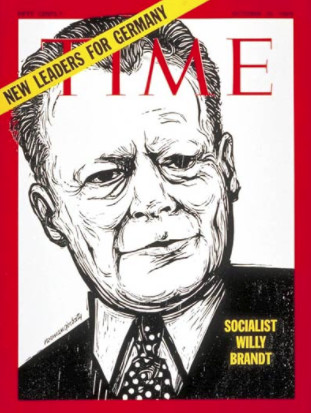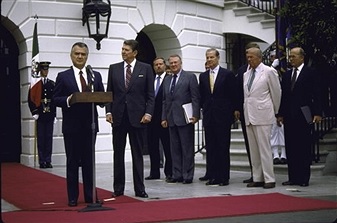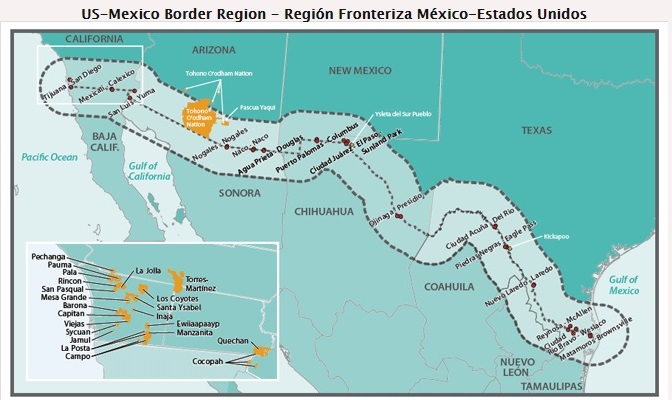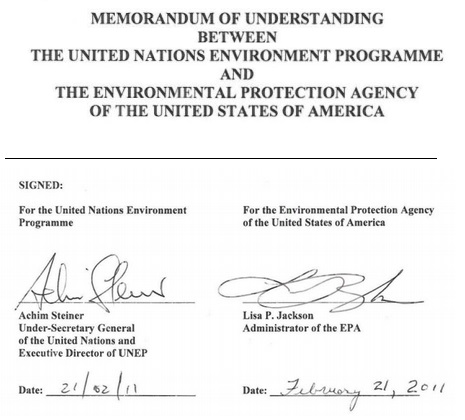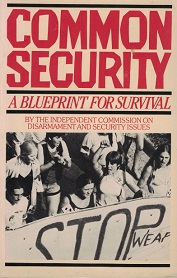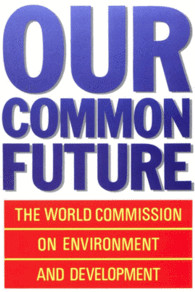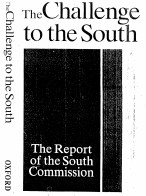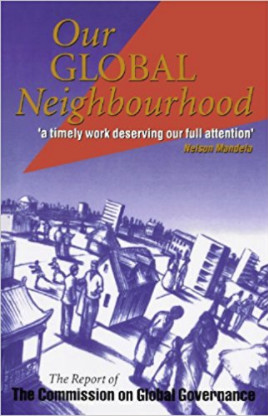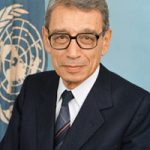
Must Read! From Vicky Davis at The Technocratic Tyranny, with my humble thanks. Superb research and detail. MH
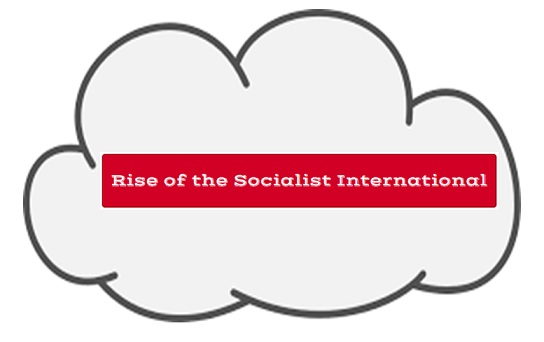
Rise of the Socialist International
Posted By: Vicky Davis
The difference between a conspiracy theory and a conspiracy fact is to be able to prove what is being said by providing the document trail and actions taken that prove the theory. I found one such proof but to understand the significance requires a brief refresher in history.
Everybody knows – or should know about the Cold War and the Iron Curtain between Communist countries of the East (Warsaw Pact) countries and the West (NATO) countries. In 1961, East Germany built a Wall dividing Berlin in half to symbolize the divide and to keep the East German people from leaving.
In 1972, President Richard Nixon entered into a series of talks regarding arms reductions in Europe. That period and those discussions became known as détente – an easing of tensions. Nixon was forced from office in 1974 and Gerald Ford became President. Gerald Ford signed an agreement called the Helsinki Final Act that is still to this day central to world politics. The U.S. Congress created the U.S. Helsinki Commission to represent U.S. interests in the Organization for Security and Co-operation in Europe.
Willy Brandt had been the Mayor of West Berlin when East Germany built the Berlin Wall. (German: Antifaschistischer Schutzwall – English: Anti-Fascist Protection Rampart) From 1966-1974 he was the Chancellor of West Germany and head of the Social Democrat Party. Brandt had been at the center of negotiations for détente but he had to resign from office before the Helsinki Final Act was signed because it was discovered that he had an East German spy on his staff. In 1976, Brandt became President of the Socialist International where he continued to work on his policy of Ostpolitik (normalization of relations between east and west).
Geopolitical Policy Commissions
According to a brief description of Cold War history pertaining to Willy Brandt on the Wilson Center website, the following is written:
…In November 1976 he (Brandt) became President of the Socialist International, and in September 1977, at the invitation of World Bank president Robert McNamara, he formed the Independent Commission for International Developmental Issues and became its chairman. As the head of what soon was called the Brandt Commission or the North-South commission, he tried to follow a method already used in Ostpolitik – a search for common interests, in this case between industrialized and developing countries…In his Reflections on the Mutuality of Interests he did not make an argument for “aid” but rather for “common interests.” (Document 5) Paul Wilkinson calls the 1980 Brandt Report the last really serious effort at designing a comprehensive international development strategy. The Brandt Report could aptly be described as international Keynesianism. Its underlying assumptions were based on economic liberalism modified to fit the special needs of the Global South. In specific terms, Brandt also argued that foreign aid should be targeted more carefully in order to assist recipients to become more economically self-sustainable.
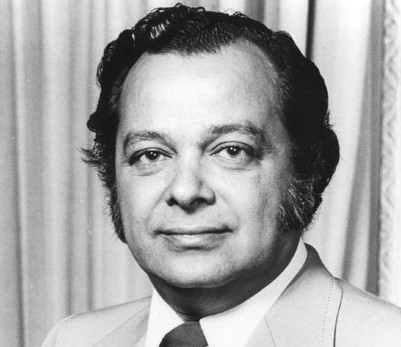
Shridath Ramphal, Secretary-General of the Commonwealth 1975-1990
The Cancún Summit of 25 heads of states or governments in October 1981 was the most tangible result of the Brandt Commission’s work. In his letter (Document 9) to the participants Brandt and his fellow commissioner Shridath Ramphal asked for an emergency program for those countries of the South most affected by the crisis. Brandt hoped that the summit participants could hold an open conversation, which would convince, especially Ronald Reagan and Margaret Thatcher, of the necessity of helping the Third World. Most attendees had no real interest in such a discussion and the summit ended with no practical results.
In February 1983, Brandt and his Commission published another report which was an updated emergency program demanding in particular reforms of the World Bank and the IMF. Brandt observed a deepening world economic crisis, which endangered not only the weakest countries of the Third World, but also the entire global community. Once again his proposals drew upon Keynesian economics to devise a plan similar to Roosevelt’s New Deal, but applied on a global scale. As with the first Brandt Report, it found many readers but had no practical impact upon policy.
As President of the Socialist International and Chairman of the Independent Commission for International Developmental Issues initiated by the World Bank, two reports were produced by Brandt. In the two reports to the right, Brandt divided the world into the “Global South” (poor countries) and the “Global North” (rich countries). He advocated huge transfers of wealth and resources from the Global North to the Global South. The trade agreements signed by the United States from 1980 forward were designed to do exactly that – to rebalance the world economy by transferring wealth (jobs and production) from the American middle class to foreign countries. Formally, the policy is called de-industrialization.
North-South Divide
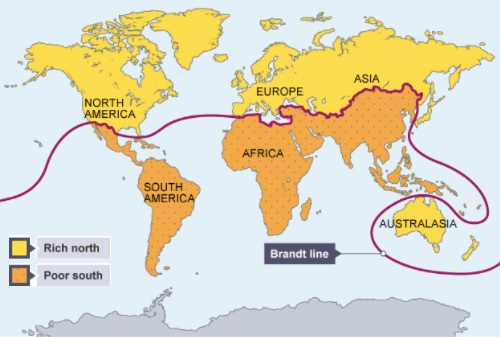
A Programme of Survival
A scanned copy of the Programme of Survival, the Independent Commission’s first report was found online. The excerpts that follow are from that scanned copy.
The significance Brandt’s Independent Commission and the report cannot be fully appreciated without an understanding of the organization of the world system of policy development and obviously most importantly who was involved. The simple purpose was define areas of Common Interest that would serve as a basis for global governance. Because of that, two sections of the report were pulled out and put into separate pdfs.
Pages 26‐28, post war – Bretton Woods Institutions
Pages 215‐226 – Annexe 2, Members of the Commission and Terms of Reference
Page 215 gives this background:
On 28 September 1977 Willy Brandt, former Chancellor of the Federal Republic of Germany, announced at a press conference in New York that he was ready to launch and chair an ‘Independent Commission on International Development Issues’.
UN Secretary‐General Kurt Waldheim showed great interest in the formation of this Independent Commission, and agreed that he would receive the first copy of the Commission’s Report.
The suggestion of creating such a Commission under the chairmanship of Mr Brandt had first been advanced by Robert S. McNamara, President of the World Bank, in a speech in Boston, early in 1977, and he reverted to it in his address to the Annual Meeting of the IMF and World Bank in Washington in the autumn of that year.
In Waldheim’s obituary in the New York Times, it was revealed that Waldheim had hidden ties to Nazi organizations.
The following names were listed as members of the Commission:
American members: Katharine Graham, Washington Post
Peter G. Peterson, Chairman of the Board of Lehman Brothers
Eminent Persons – invited to testify: Harlan Cleveland, USA
Henry Kissinger, USA
On page 9 of the report, these paragraphs give an idea of the thinking behind the report:
Destruction or Development?
Our Report is based on what appears to be the simplest common interest: that mankind wants to survive, and one might even add has the moral obligation to survive. This not only raises the traditional questions of peace and war, but also of how to overcome world hunger, mass misery and alarming disparities between the living conditions of rich and poor.
If reduced to a simple denominator, this Report deals with peace. War is often thought of in terms of military conflict, or even annihilation. But there is a growing awareness that an equal danger might be chaos — as a result of mass hunger, economic disaster, environmental catastrophes, and terrorism. So we should not think only of reducing the traditional threats to peace, but also of the need for change from chaos to order.
Common Interests
The environment as the ultimate common interest became an issue for European socialists in the late 1960s. In the 40th Anniversary report of the United Nations Environmental Programme a narrative history of the global movement was provided. The United Nations Conference on the Human Environment was held in Stockholm, Sweden in June of 1972. The excerpts that follow are from that history:
The Stockholm Conference had agreed on a Declaration with an associated set of Principles. It had agreed on an Action Plan of 109 recommendations: the world’s first tentative blueprint for planetary environmental management. Its scope was enormous, calling for global cooperation to monitor the biosphere, safeguard ecosystems, curb marine pollution, improve housing in poor countries, collect genetic samples, protect whales and other endangered species, study energy needs and sources, aid population planning, conserve soils and forests and fisheries, promote environmental education and training and information exchange, and adapt trade and aid policies so as to share equitably the burdens of environmental protection. Page 27
“The Stockholm Declaration on the Human Environment, taken together with the Rio Declaration on Environment and Development agreed in June 1992, now has pride of place among the ever‐growing corpus of international law relating to the environment.” Page 17
The World Bank, itself a Specialized Agency of the United Nations, though with a rather special statute and status, was increasingly active in the field of environment. As Robert McNamara, the World Bank Group’s President, would later point out in his speech to the Stockholm conference: “Our experience is that environmental protection can be built into development projects as competently and successfully as any other requisite element.” The Bank, Mr. McNamara said, didn’t limit its operations simply to the environment side of development projects. “It finances many projects that are specifically directed at environmental goals — urban water supply and sewerage treatment, for example, as well as soil erosion control, and water resources management.”17 Page 15
Simon The Socialist Says and American Politicians Jump
In 1983, President Ronald Reagan and Mexican President Miguel de la Madrid signed a treaty. Mexico was considered to be a “Global South” country – not because Mexico was a poor country without resources, but because the wealth of Mexico was concentrated in the hands of a few. The treaty was supposedly for cooperation in the environmental cleanup of the border region – but it was more about creating an international region of “common interest” between the Global North (U.S) and the Global South (Mexico).
The treaty is informally known as the La Paz treaty because it was signed in La Paz Mexico on August 14, 1983. Entered into force February 16, 1984. 35 UST 2916; TIAS 10827; 1352 UNTS 67.
67.
To the left is the La Paz Treaty border map. The circled area is a geographically defined international zone. The EPA Administrator was designated to carry out the terms of the treaty along with the Administrator of the Mexican EPA.
Article 9 of the La Paz treaty says the following:
“Taking into account the subjects to be examined jointly, the national coordinators may invite, as appropriate, representatives of federal, state and municipal governments to participate in the meetings provided for in this Agreement. By mutual agreement they may also invite representatives of international governmental or non-governmental organizations who may be able to contribute some element of expertise on problems to be solved.”
In 2011, EPA Administrator Lisa Jackson signed a Memorandum of Understanding with the United Nations Environmental Programme (UNEP). Note all of the references to previous UN agreements. That’s called incorporation by reference. Those previous agreements are added to the new agreement by including the reference.
The point of including the La Paz Treaty was to show that the World Bank Policy – through Willy Brandt’s Commission was implemented by the Reagan Administration. In 1990, the Bush 41 Administration expanded upon the North-South policy of the La Paz Treaty with the announcement of the Enterprise of the Americas Initiative. FAQ In the announcement, Bush said the following:
The three pillars of our new initiative are trade, investment, and debt. To expand trade, I propose that we begin the process of creating a hemisphere-wide free trade zone; to increase investment, that we adopt measures to create a new flow of capital into the region; and to further ease the burden of debt, a new approach to debt in the region with important benefits for our environment.
Obviously, that initiative led to the NAFTA agreement and “that giant sucking sound” of production and jobs leaving the United States just a few years later.
Rise of the Socialist International
Throughout the 1980’s a number of other Commissions were initiated leading to Willy Brandt’s final Commission – the Commission on Global Governance.
The last report, Our Global Neighbourhood was a call and a plan for global governance. It was produced by Willy Brandt’s Commission on Global Governance. He didn’t lead it, but he did initiate it. It was published for the public in 1995 but it likely was distributed to world leaders before then.
The following is an excerpt from the online Encyclopedia Britannica regarding the history of the Commission on Global Governance:
The Commission on Global Governance came about at the end of the Cold War. The commission believed that the easing of East-West tension created a better environment for global cooperation. Therefore, it sought to examine the best means of achieving a new global order. The commission was founded in the aftermath of two meetings organized by West German Chancellor Willy Brandt. The first meeting, held in January 1990 in Königswinter, West Germany, reunited members of the Independent Commission on Disarmament and Security Issues, the World Commission of Environment and Development, and the South Commission. The attendees believed that, although there seemed to be overall improvement in world affairs, there was still a need for further commitment to multilateral action and global cooperation. The Stockholm Initiative on Global Security and Governance, issued in April 1991, articulated the desire for a more proficient system of global governance.
The Commission on Global Governance was thus set up in April 1992 to further explore the new challenges of global interdependence. Brandt invited former Swedish prime minister Ingvar Carlsson and former secretary-general of the Commonwealth of Nations Shridath Ramphal of Guyana to cochair the commission. Together they presented the proposal for the commission to United Nations Secretary-General Boutros Boutros-Ghali, who assured them of his support for their project of reassessing multilateral action.
The Stockholm Initiative was published in the EcoSocialist Review, Summer of 1991. The EcoSocialist was apparently a magazine of the Democratic Socialists of America. The history of the DSAUSA is worth the time to read. A copy of the Initiative was found in an article in the archives of the DSAUSA.
Socialist Internationalist Stockholm Initiative
The following are just a couple of the most significant from this writer’s point of view:
- improved United Nations capabilities for anticipating and preventing conflicts, in particular the establishment of a global emergency system;
- the elaboration of a global law enforcement arrangement, in line with the United Nations Charter, focusing on the role of sanctions and on military enforcement measures;
- a strengthened debt strategy, introducing a strong element of debt forgiveness to radically cut the debt overhang; by terms and conditions in Paris Club reschedulings that go far beyond today’s in providing relief and applying to a broader range of countries
- that fees are levied on the emission of pollutants affecting the global environment, in particular carbon dioxide emissions from the burning of fossil fuels;
- an international energy dialogue promoting a more efficient use of the world’s energy resources, and, in particular, the use of alternatives and renewable energy sources, such as solar energy;
Under the heading of GLOBAL GOVERNANCE
- that the International Monetary Fund and the World Bank be coordinated, among themselves and with the United Nations system and GATT, with the aim of clearer division of labor, better harmony and full universality in their work; [Note: recall that Mikhail Gorbachev in his “New World Order” speech said that “they needed to design a “new machinery” by which he meant governing system for the functioning of the world economy and there needed to be a new international division of labor.
- that a World Summit on Global Governance be called, similar to the meetings in San Francisco and at Bretton Woods in the 1940;
- a strengthened debt strategy, introducing a strong element of debt forgiveness to radically cut the debt overhang; by terms and conditions in Paris Club reschedulings that go far beyond today’s in providing relief and applying to a broader range of countries
- as a matter of priority, the establishment of an Independent International Commission on Global Governance
While Bill Clinton was campaigning for President, he was Chairman of the Democratic Leadership Council (DLC). The DLC represented the Tech Industry (aka Atari Democrats).
When Bill Clinton took office in January of 1993, the stage was already set for a nationwide, interconnected telecommunications system – with a redesign of government systems in the planning. There were two major redesign projects underway – the health care system and transportation systems.
The Socialist Revolution occurred inside the federal government. From 15 years of observation, it’s clear that Democrats understand structure and process within government. Republicans are just a bunch of empty suits who talk about money. Because of that, we lost our American government to socialist systems designers who organized and collectivized power within the government through systems design and they rewrote the rules (processes) within government to subjugate everything that is American to the global order of the socialists.
The following is from Chapter 4 of Our Global Neighborhood. In past writings, I’ve called the system of interdependence – an interlocking system (deadly embrace) that is a criss-cross double cross for people in both countries that are being locked into the global socialist system.
Chapter Four – Managing Economic Interdependence, Page 108-109
Several functional, specialist institutions should also be mentioned, such as the International Telecommunications Union (ITU), the International Maritime Organisation, the Bank for International Settlements (BIS), and the Paris Club. ITU has responsibility–now shared with GATT–for creating a regime of global governance for the rapidly expanding, interconnected network of telecommunication, multimedia, and information technology systems. BIS provides the world’s financial system with an underpinning of co-operative supervision. In these quiet, unspectacular ways, a system of global governance is being put in place, albeit on a piecemeal basis.
After our National Information Infrastructure (NII) was designed, Al Gore flew to Brazil to speak to the International Telecommunications Union (ITU) to request their assistance in building the Global Information Infrastructure (GII).
From Al Gore’s government biography.
“To help strengthen and support democracy and economic development in countries throughout the world, Vice President Gore proposed the development of a Global Information Infrastructure. He led the U.S. delegation to the inauguration of the first freely elected President of South Africa, Nelson Mandela, and has worked closely with Russian Prime Minister Viktor Chernomyrdin to build a partnership between the two former adversaries. The Gore-Chernomyrdin Commission was formed by Presidents Clinton and Yeltsin to foster economic cooperation between their nations, particularly on the issues of space cooperation, business, science and technology, defense conversion, energy and the environment. His leadership was critical in getting passage through Congress of the historic North American Free Trade Agreement.”
On March 21, 1994, Al Gore traveled to Brazil to speak at a conference of the International Telecommunications Union (ITU). The first words out of his mouth: “I have come here, 8,000 kilometers from my home, to ask you to help create a Global Information Infrastructure.”
How does the International Maritime Organization (IMO) fit into this? Ports – inland and seaports for global commerce. Recently, there has been a lot of talk about China’s One Belt, One Road strategy for control of ports for commerce. It’s being reported that this strategy was announced in 2013. While it may be true that it was announced in 2013, the design of the global economy and port system began long before then. Since the Intermodal Surface Transportation Efficiency Act of 1991 called for the creation of intermodal commerce zones (ports) and that legislation also made reference to a Pan-American highway, the idea goes back at least that far and more likely, it goes back to the late 1980s.
If Americans want to reclaim their government, they need to understand how they lost it. It’s under the control of the technocrats of the Socialist International. Our systems of government have been and continue to be (it takes a long time) integrated into international systems. That integration must be stopped, rolled back and our government needs to be purged of the traitors who cooperated in the consolidation of power and the transfer of sovereignty through systems design.








